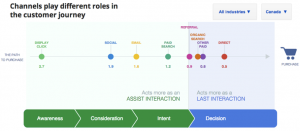 All the self-proclaimed social media junkies raise your hands.
All the self-proclaimed social media junkies raise your hands.
All of the social media skeptics, keep reading.
Here’s the thing about social media, you can tap into a huge audience – between Facebook, Twitter, LinkedIn, Slideshare, and all those other platforms that seem to pop up on a daily basis – but you need to be willing to commit to the effort of keeping up your social media efforts on a consistent basis and you need a strategy.
Why? Because reasons (I kid, I kid!).
But really, you need a social media strategy for reasons that mirror why you need a general marketing strategy. If you want to get results, you need goals and a way to measure whether you’re achieving them. Otherwise, you’re just posting to post (which is kind of like talking to hear your own voice).
So what do you need to know and do to be sure you win at social media in 2015?
Define Your Audience
Which networks are you going to use? Which networks are going to reach your audience? Recently, analyzing some metrics for a client, we discovered that Facebook had delivered over 100 leads while LinkedIn delivered none, nor did Twitter. This doesn’t mean everyone should double down on Facebook (another client had the exact opposite results, with zero leads from Facebook and over 100 from LinkedIn), but it does mean that you’re efforts should be focused on the platforms on which your audience is most likely to be found.
Find out where your audience is interactive. Maybe they’re mostly on twitter. Maybe they’re on Facebook. Another client of mine regularly has content shared via Twitter retweets, even though they have the most audience interaction on Facebook. A good way to learn more about your audience is through the creation of an audience persona. Download our audience persona template here or create your own.
Defining your audience and figuring out where they’re active leads us to the next part of your strategy…
Set Goals
Like any other marketing (or business) effort, you can’t measure your success without setting goals. Are you looking to increase brand awareness? Share your content to drive traffic? Generate more leads for your business?
How are you going to measure the success of your social media marketing efforts? These goals should be in line with your overall business goals; for instance, if you’re looking to grow your business by X%, you may set a social media marketing goal of generating Y number of leads through your social marketing efforts.
As always, the key to setting goals is to ensure that they are SMART – specific, measurable, attainable, realistic, and time-bound.
Have A Content Strategy
You’ve found your audience and you’ve set your goals. What’s next? Now its time to determine what exactly you’re going to talk about. Think of social media as one big cocktail party. Just as you would never walk into a party and talk only about yourself (and if you DO, you may have noticed that nobody talks with you for very long), you shouldn’t just post about your products and services on Facebook, LinkedIn, etc. It’s okay to talk about yourself a bit, but the self promotion should be mixed in with conversation (ask your audience a question, comment on a trend, etc.) and education (tell your audience something helpful, offer up a suggestion, solve a problem, etc.).
To be educational, you’ve got to have good content to share. Ideally it should be your own and not someone else’s. This is your opportunity to showcase your expertise, establish thought leadership, and position yourself to make a sale – all in a way that is subtle and percieved as helpful. Your content can come in the form of blogs, whitepapers, ebooks, videos, infographics, webinars, etc. The list goes on and on and the key thing to understand is that it is less important what FORM your content takes than how helpful is to the person consuming it.
Once you’ve got some good, educational content, you’ll need to determine which content will be shared on which networks. This is where good audience personas can help. If you know your audience and know what platforms they’re on, you can identify opportunities to get in front of qualified leads by sharing your content on social media. For example, if you are targeting meeting and event planners, its a good idea to share your great content on LinkedIn groups for conference planners, event organizers, etc.
Look at the times when your audience is most active so you can determine what content will be posted when on which network to obtain the greatest reach. Facebook and Twitter both offer insights to help you find out when your audience is active and what type of content they’re interacting with.
Plan to Monitor Your Streams
Posting is all well and good but if you’re not monitoring what people are saying, you’re not supporting your posting efforts. What are you listening for? Well, here are a few ideas
- Mentions – Are people sharing your information? Are they talking about your product? You can track all of these mentions on tools like Hootsuite or Hubspot. Every mention is an opportunity to start a conversation. Consider how and if you’ll respond when you identify these conversations.
- Prospects, Leads or Customers – Hubspot’s social monitoring tool is great for this. You can track when your customers or leads tweet or post, giving you the chance to respond and share your knowledge!
- External Events – If you’re not at that big industry trade show, you better be following it online. Thankfully, most events these days have hashtags to make that easy. Set up a monitoring stream to follow the buzz – even if you are at the event – so you can be a part of the conversation.
- Internal Events – If your brand or organization is leading a webinar or a Twitter chat, be sure to follow it so you can see what participants are saying.
- Your competitors – Track your competitors to know what else is going on in your industry and what’s going on in the community around you.
All of this tracking can seem incredibly time consuming, but that doesn’t need to be the case. With the right tools (we like HubSpot and HootSuite), you can set up your monitoring streams once and then let the software search the social world for you.
Analyze your metrics
Know what metrics are going to help you measure your success so you can analyze your efforts and use the results of that analysis to tweak, adjust and fine tune. If you have HubSpot, you already have access to this data – from showing the reach and interactions with your posts, to how many clicks and conversions each network produces, it includes a complete, closed loop reporting tool. If you don’t have HubSpot, networks like Twitter and Facebook offer up analytics on reach, interactions, etc. Using these metrics – whether likes or followers or clicks – will help you ultimately determine if your social marketing strategy is successful and what, if any, efforts should be modified to help you obtain your marketing goals.
(227)








